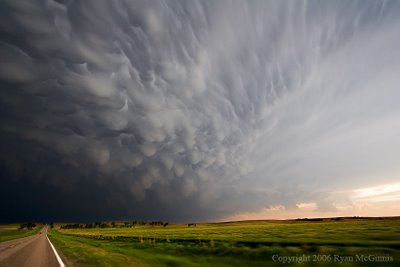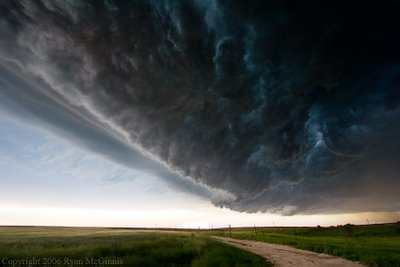
SWEETWATER, Tex. — The wind turbines that recently went up on Louis Brooks’s ranch are twice as high as the Statue of Liberty, with blades that span as wide as the wingspan of a jumbo jet. More important from his point of view, he is paid $500 a month apiece to permit 78 of them on his land, with 76 more on the way.
“That’s just money you’re hearing,” he said as they hummed in a brisk breeze recently.
Texas, once the oil capital of North America, is rapidly turning into the capital of wind power. After breakneck growth the last three years, Texas has reached the point that more than 3 percent of its electricity, enough to supply power to one million homes, comes from wind turbines.
Texans are even turning tapped-out oil fields into wind farms, and no less an oilman than Boone Pickens is getting into alternative energy.
“I have the same feelings about wind,” Mr. Pickens said in an interview, “as I had about the best oil field I ever found.” He is planning to build the biggest wind farm in the world, a $10 billion behemoth that could power a small city by itself.
Wind turbines were once a marginal form of electrical generation. But amid rising concern about greenhouse gases from coal-burning power plants, wind power is booming. Installed wind capacity in the United States grew 45 percent last year, albeit from a small base, and a comparable increase is expected this year.
At growth rates like that, experts said, wind power could eventually make an important contribution to the nation’s electrical supply. It already supplies about 1 percent of American electricity, powering the equivalent of 4.5 million homes. Environmental advocates contend it could eventually hit 20 percent, as has already happened in Denmark. Energy consultants say that 5 to 7 percent is a more realistic goal in this country.
The United States recently overtook Spain as the world’s second-largest wind power market, after Germany, with $9 billion invested last year. A recent study by Emerging Energy Research, a consulting firm in Cambridge, Mass., projected $65 billion in investment from 2007 to 2015.
Despite the attraction of wind as a nearly pollution-free power source, it does have limitations. Though the gap is closing, electricity from wind remains costlier than that generated from fossil fuels. Moreover, wind power is intermittent and unpredictable, and the hottest days, when electricity is needed most, are usually not windy.
The turbines are getting bigger and their blades can kill birds and bats. Aesthetic and wildlife issues have led to opposition emerging around the country, particularly in coastal areas like Cape Cod. Some opposition in Texas has cropped up as well, including lawsuits to halt wind farms that were thought to be eyesores or harmful to wetlands.
But the opposition has been limited, and has done little to slow the rapid growth of wind power in Texas. Some Texans see the sleek new turbines as a welcome change in the landscape.
“Texas has been looking at oil and gas rigs for 100 years, and frankly, wind turbines look a little nicer,” said Jerry Patterson, the Texas land commissioner, whose responsibilities include leasing state lands for wind energy development. “We’re No. 1 in wind in the United States, and that will never change.”
Texas surpassed California as the top wind farm state in 2006. In January alone, new wind farms representing $700 million of investment went into operation in Texas, supplying power sufficient for 100,000 homes.
Supporters say Texas is ideal for wind-power development, not just because it is windy. It also has sparsely populated land for wind farms, fast-growing cities and a friendly regulatory environment for developers.
“Texas could be a model for the entire nation,” said Patrick Woodson, a senior development executive with E.On, a German utility operating here.
The quaint windmills of old have been replaced by turbines that stand as high as 20-story buildings, with blades longer than a football field and each capable of generating electricity for small communities. Powerful turbines are able to capture power even when the wind is relatively weak, and they help to lower the cost per kilowatt hour.
Much of the boom in the United States is being driven by foreign power companies with experience developing wind projects, including Iberdrola of Spain, Energias de Portugal and Windkraft Nord of Germany. Foreign companies own two-thirds of the wind projects under construction in Texas.
A longer-term problem is potential bottlenecks in getting wind power from the places best equipped to produce it to the populous areas that need electricity. The part of the United States with the highest wind potential is a corridor stretching north from Texas through the middle of the country, including sparsely populated states like Montana and the Dakotas. Power is needed most in the dense cities of the coasts, but building new transmission lines over such long distances is certain to be expensive and controversial.
“We need a national vision for transmission like we have with the national highway system,” said Robert Gramlich, policy director for the American Wind Energy Association. “We have to get over the hump of having a patchwork of electric utility fiefdoms.”
Texas is better equipped to deal with the transmission problems that snarl wind energy in other states because a single agency operates the electrical grid and manages the deregulated utility market in most of the state.
Last July, the Texas Public Utility Commission approved transmission lines across the state capable of delivering as much as 25,000 megawatts of wind energy by 2012, presuming the boom continues. That would be five times the wind power generated in the state today, and it would drive future national growth.
Shell and the TXU Corporation are planning to build a 3,000-megawatt wind farm north of here in the Texas Panhandle, leapfrogging two FPL Energy Texas wind farms to become the biggest in the world.
Not to be outdone, Mr. Pickens is planning his own 150,000-acre Panhandle wind farm of 4,000 megawatts that would be even larger and cost him $10 billion.
“I like wind because it’s renewable and it’s clean and you know you are not going to be dealing with a production decline curve,” Mr. Pickens said. “Decline curves finally wore me out in the oil business.”
At the end of 2007, Texas ranked No. 1 in the nation with installed wind power of 4,356 megawatts (and 1,238 under construction), far outdistancing California’s 2,439 megawatts (and 165 under construction). Minnesota and Iowa came in third and fourth with almost 1,300 megawatts each (and 46 and 116 under construction, respectively).
Iowa, Minnesota, Colorado and Oregon, states with smaller populations than Texas, all get 5 to 8 percent of their power from wind farms, according to estimates by the American Wind Energy Association.
It has dawned on many Texans in recent years that wind power, whatever its other pros and cons, represents a potent new strategy for rural economic development.
Since the wind boom began a few years ago, the total value of property here in Nolan County has doubled, and the county judge, Tim Fambrough, estimated it would increase an additional 25 percent this year. County property taxes are going down, home values are going up and the county has extra funds to remodel the courthouse and improve road maintenance.
“Wind reminds us of the old oil and gas booms,” Mr. Fambrough said.
Teenagers who used to flee small towns like Sweetwater after high school are sticking around to take technical courses in local junior colleges and then work on wind farms. Marginal ranches and cotton farms are worth more with wind turbines on them.
“I mean, even the worst days for wind don’t compare to the busts in the oil business,” said Bobby Clark, a General Electric wind technician who gave up hauling chemicals in the oil fields southwest of here to live and work in Sweetwater. “I saw my daddy go from rags to riches and back in the oil business, and I sleep better.”
Wind companies are remodeling abandoned buildings, and new stores, hotels and restaurants have opened around this old railroad town.
Dandy’s Western Wear, the local cowboy attire shop, cannot keep enough python skin and cowhide boots in stock because of all the Danes and Germans who have come to town to invest and work in the wind fields, then take home Texas souvenirs.
“Wind has invigorated our business like you wouldn’t believe,” said Marty Foust, Dandy’s owner, who recently put in new carpeting and air-conditioning. “When you watch the news you can get depressed about the economy, but we don’t get depressed. We’re now in our own bubble.”
Original here













